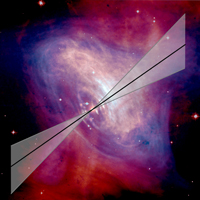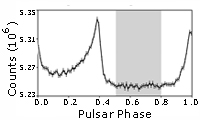INTEGRAL detects signature of critical cosmic accelerator
29 August 2008
Polarized photons provide an insight into the nature and energies of the particles that radiated them; this in turn gives us a handle on the nature of the acceleration processes at work in cosmic sources. INTEGRAL's detection of polarized gamma-rays from the Crab pulsar, reported by Dean and colleagues in the 29 August issue of Science, has significant implications for many aspects of high-energy accelerators.
 |
|
Composite image of the Crab from Chandra (X-ray, blue) and the Hubble Space Telescope (optical, red). The polarization vector, inferred from INTEGRAL/SPI measurements, is superimposed. |
The observation of high-energy particles and photons confronts scientists with the obvious but difficult question of where and how charged particles can be accelerated up to the energies required for them to radiate in the high-energy regime. Environments where particles can be accelerated are also environments where particles can easily radiate their energy away, and models must account for a system where the potentially large amount of energy available through shocks, gravitation, or rotation can be transferred to charged particles in an efficient and orderly fashion.
The observation of TeV gamma-rays from the Crab nebula is the almost prototypical example of this class of problem. These gamma-rays are thought to originate by inverse Compton scattering of high-energy (up to a few 1015 eV) electrons with ambient synchrotron photons (observed in great detail at radio frequencies). But do these high energy electrons actually exist in the nebula? Low energy electrons clearly do, as demonstrated by the detection of polarized radiation from the radio to the few hundred of keV energy range.
 |
|
The polarization analysis was performed on 0.1-1.0 MeV events falling within the 0.5 to 0.8 phase interval of the pulsar period. |
By analyzing about 600 observations of the Crab nebula and pulsar taken with the SPI instrument on INTEGRAL during the three years up to April 2006, Dean and colleagues were able to show that the emission in the 0.1 to 1 MeV energy range is linearly polarized to a high degree (about 50%).
The angle of polarization coincides with the pulsar's rotation axis. Although INTEGRAL cannot pinpoint where the photons are produced, the orientation of the polarization can be directly correlated with the orientation of the magnetic field where the photons are radiated. With this information, and by leveraging information from observations at other energies, Dean at al. were able to estimate that the radiating electrons must have an energy of the order of 1015 eV.
This observation, which can be seen as almost a direct measurement of the energy of the electrons involved, indicates that the Crab pulsar, and similar objects, can accelerate electrons to the energies required to explain a wide range of astronomical observations.
With the detection of polarized emission from the Crab pulsar another piece of the cosmic accelerators puzzle has been revealed.
Related Publication
Dean, A.J., et al., "Polarized Gamma-Ray Emission from the Crab", Science, Vol. 321, no. 5893, pp.1183-1185, 29 August 2008. DOI:10.1126/science.1149056


